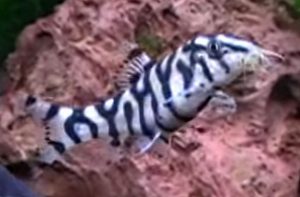The Lohachata Botia Loach (Botia lohachata) is also known to tropical fish keeping enthusiasts as the Yoyo Loach, Almorha Loach, Pakistani Loach, Reticulated Loach, and Y-Loach.
Because only a single juvenile specimen was used to originally describe Botia lohachata, the validity of the species has never been fully resolved. Grant in 2007 considered it as a distinct species that has definitely been exported for the aquarium trade, but confirmation is still required.
Juvenile Lohachata Botia Loaches have a gold to silver metallic sheen that turns a gray to green in adults, without the sheen. Three unconnected “Y” markings typically occur in adult and juvenile specimens which give rise to one of their common names, the Yoyo Loach.
The dorsal fin of the Lohachata Botia loach has 2 to 3 bands; the caudal fin has 3 to 4 bands, the pectoral fins usually have 3 bands, the anal fin has 1 or 2 bands, and the ventral fins usually have 1 to 4 bands that increase with age.
The Lohachata Botia Loach can further be identified by the four pairs of barbels that protrude from their mouth and their silvery gold with irregular black striping color.
The Lohachata Botia Loach is often believed to be a scaleless fish but they do have very small scales that are embedded in their skin.
Like all loaches, the Lohachata Botia Loach is an active scavenger. They are a semi aggressive species that enjoy the company of their own species. They generally school with other loaches of the same size and age, and should be housed in groups of 6 or more specimens in an aquarium environment.
Lohachata Botia Loaches require an aquarium of at least 30 gallons with a sandy or fine gravel substrate, some plants, some smooth river rock, a few pieces of driftwood or bogwood for them to hide among, and plenty of free swimming space. They like holes in driftwood or caves in the rockwork to hide and sleep.
Because Lohachata Botia Loaches are found in shaded jungle streams, they prefer subdued lighting or a few floating plants in their tank to diffuse the lighting and provide cover.
All botia loaches are excellent diggers, and because of their delicate barbels, should be provided with a sandy substrate in their tank. These loaches are also excellent jumpers and require a tightly fitting tank cover.
Lohachata Botia Loaches do best in well oxygenated water with some degree of current in their tank. They are intolerant to the accumulation of organic wastes and need spotless water conditions to thrive. For this reason, many tropical fish keeping enthusiasts opt for using a quality canister filter for this species. They should never be introduced into a biologically immature aquarium. Even so, they require regular 25% to 50% weekly water changes.
The breeding habits of this particular species have never been recorded, and to date no captive breeding program has yet been initiated.
Juvenile Botia Lohachata will eat most prepared foods and should be fed small portions several times a day. Older specimens sometimes become finicky eaters and can be fed tubifex, blackworms, small snails, etc. to augment their diet.
Juvenile Botia lohachata are occasionally introduced with mixed botia shipments and are sometimes available when they are 1-3/4″ to 2-1/2″ in size.
Minimum Tank Size: 30 gallons
Care Level: Moderate
Temperament: Semi Aggressive
Aquarium Hardiness: Moderately Hardy
Water Conditions: 72-86° F, KH 8-12, pH 6.0-7.5
Max Size: 5″
Color Form: Black, White, Yellow
Diet: Omnivore
Compatibility: Good community tank fish
Origin: Bangladesh, North and Northeast India
Family: Cobitidae
Lifespan: 8 – 12 years
Aquarist Experience Level: Intermediate




